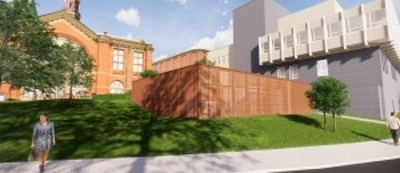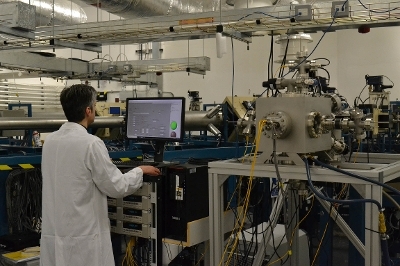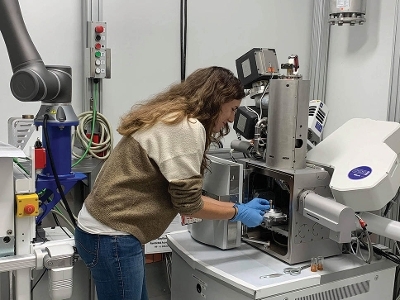At the cutting edge of nuclear energy - advancing materials development
Chris Grovenor FIMMM, Malcolm Joyce and Francis Livens of the UK’s National Nuclear User Facility Management Group discuss the opportunities for researchers to advance nuclear materials development.

Nuclear fission has been recognised by the UK Government as having an important role in contributing to future energy security and decarbonising the energy network. The National Nuclear User Facility (NNUF) is a government investment in this nuclear future, with established facilities at the University of Manchester’s Dalton Cumbrian Facility (DCF), the Culham Materials Research Facility and the National Nuclear Laboratory available for external access to undertake academic and industrial work on nuclear materials.
A more recent development in 2019 was a further £80mln of government funding to enhance national facilities for the study of radioactive materials. This Phase 2 of NNUF will run until April 2023, and supports projects in UK universities and national laboratories, including a neutron source at the University of Birmingham, nuclear robotics at Bristol, Manchester and the UK Atomic Energy Authority (UKAEA), a compact Accelerator Mass Spectrometer at Lancaster, and a new active Atom Probe Tomography facility in Oxford. Representatives from the UK nuclear sector were closely involved in conceiving NNUF(2).
‘This is a substantial investment in the research infrastructure needed to underpin the UK’s future plans for using nuclear energy to decarbonise our energy requirements and to undertake world-leading research and technology development in decommissioning and waste disposal strategies,’ says Professor Chris Grovenor, Principal Investigator of the NNUF(2) Management Group.

The £80mln award also includes £6.5mln to allow any UK-based university researcher, and their international collaborators, to apply for access to facilities affiliated with NNUF, including those that come online over the next few months and years. Easy and free access to these facilities is intended to help attract talented graduates into nuclear science and technology, giving them the opportunities and training to be future leaders in this important sector.
The NNUF Management Group will run a continuous quarterly access application process for the lifetime of the project. The first call covers access in the period October – December 2020. Potential applicants are encouraged to reach out to the contact person at any facility or facilities they might be interested in using to initiate a discussion, before completing a simple application form.
Defect detection
Dr Jack Haley from the Department of Materials at the University of Oxford, UK, used the existing NNUF facilities during his PhD research. He says, ‘My research revolved around studying the dislocation loops, and other defects, that are produced by neutron, proton or heavy-ion damage to examine the similarities and differences in their damage microstructure. I focused my research on iron-chromium alloys. These are essentially ferritic steels, minus the carbon and other alloying elements, and are helpful for studying fundamental damage effects in nuclear-relevant steels.’
He undertook the heavy-ion damage portion of his research at the Surrey Ion Beam Centre, plus the Dalton Cumbrian Facility for implanting protons. ‘The Dalton Cumbrian Facility – supported by the first round of NNUF funding – was used for the proton implantation as their accelerators are capable of much higher currents than those typically used for heavy-ion damage and allow proton damage to accumulate at a reasonable rate.’
The process of getting access to the facilities is, according to Haley, straightforward, with the only requirement being filling out an application form and sending it in. ‘The staff scientists at each of the facilities are also very helpful when it comes to planning an experiment, as they are able to offer advice on many of the practical aspects and how to make the most of the beam time.’
He adds that the research he conducted at the DCF was challenging and that it required several 3mm disks being irradiated at the same time – a new sample holder was created to fit on the irradiation stage with good thermal conductivity for the heating/cooling system. ‘Dr Paul Wady of DCF was particularly helpful with preparing for this experiment. The proton irradiation was quite lengthy, ~48hrs, which required continuous beam and sample monitoring. To enable this, DCF staff trained myself and another colleague to operate their accelerator so that we could be one of the two operators attending the beam at any one time.’
He currently works as a Postdoc on electron microscopy analysis of zirconium fuel cladding for the next generation of reactors in the UK.
Proton-irradiated alloys

Dr Alexandra Cackett, an Experimental Materials Scientist at the UKAEA, also used the NNUF facilities under Phase 1. Cackett’s research is focused on plasticity size effects in copper (Cu) alloys used in fusion applications. ‘My main sample set included CuCrZr that had undergone heat treatments at different temperatures and a sub-set of these were proton-irradiated. All these samples had to be well characterised to understand their microstructure, then small-scale mechanical tests, such as those used to monitor radioactive materials, were carried out over a range of length-scales,’ Cackett says.
‘Nanoindentation using spherical tips with a range in radii from 2-150μm formed a large part of this, since it is possible to infer stress-strain data using this technique. Pillar compression testing was also carried out for the irradiated samples and these were all manufactured in the Materials Research Facility (MRF) located at UKAEA using the focused ion beam instrument.
‘I could prepare samples, perform characterisation and do mechanical testing without having to transport samples from place to place. I was also able to carry out the work myself after being trained on the instruments.’
As the UKAEA was one of the members of a European collaborative project that Cackett was part of, she could use the MRF to conduct experimental work to contribute to the project.
Like Haley, Cackett also used an ion beam accelerator at DCF in her PhD work on irradiated material. She explains that she applied for beam time via the UK National Ion Beam Centre’s quarterly proposal call and had to provide a description of the experimental details, and a scientific and technical case for the work.
Having completed her PhD, she is now an Experimental Materials Scientist in the UKAEA’s MRF and expecting to receive some neutron-irradiated CuCrZr that was inserted into the MARIA reactor in Poland. ‘I would like to repeat some of the small-scale tests I performed previously to study the difference in mechanical properties following irradiation. I will be able to do this in the MRF as the instruments can be used with active materials. I also hope to be involved in other projects being done in the MRF looking at potential new materials for fusion reactors and developing small-scale techniques that can be used for monitoring samples from active environments,’ she says.
Other projects that have been funded under NNUF Phase 1 include installing facilities for depositing uranium oxide thin films to study radiation damage processes (with the University of Bristol), characterisation of graphite samples from advanced gas cooled reactor (AGR) core to study porosity (with the University of Manchester), and characterising carbonaceous deposits on AGR fuel pins and evaluating the impairment of heat transfer from the fuel pin to the coolant caused by the deposit.







